(click on photos to enlarge image)
MARKS OF EUROPEAN SILVER PLATE:
XIII. NORBLIN, RUSSIA/POLAND
(Revised & Updated Version of Members' Window # 57)
Three years ago I published a Members' Window in ASCAS
newsletter devoted to the Warsaw silver plate factories Fraget
and Norblin [1]. Since then I found new material, both in
literature and in my recent acquisitions, which has allowed me
the revising and updating of the Fraget part of my previous
Members' Window [2]. Now it is time to revise the Norblin part.
The history of the Norblin company is well known [3,4,5,6].
Vincent Norblin (1805-1872) was born in Paris. His life story
reads like a cheap fiction. At the age of fourteen, Vincent
appeared in Warsaw, where his father, the jeweller Alexandre
Jean Constantin Norblin (1777-1828), together with Vincent’s
uncles was running a small enterprise, a bronze foundry (founded
in 1819). After his apprenticeship at his father’s factory and
studies abroad, Vincent found work in Warsaw in a silver company
managed by the French jeweller Jean Cerisy (in 1822). Cerisy
had married the daughter of Filip Vorbrodt, a local businessman of
German origin, who moved to Warsaw from the small German
principality of Anhalt. After the death of Filip Vorbrodt, the
wife of Cerisy, Henriette Leopoldina Augusta,
inherited her father's silver
company. However, in 1831, Jean Cerisy died suddenly and Vincent
Norblin (Wincenty Norblin in Polish) married his widow and
became the boss of the firm.
In 1843, Wincenty Norblin, together with Jan Meylert, former
associate of Cerisy, organised the new jewellery firm Norblin i
Spólka (Norblin & Co.), where the
bronze foundry of his father was also included. After that,
Wincenty permanently renewed the machinery in his factory, which
resulted in a steady increase of the production, and in
1853-1855, following the latest improvement at the Fraget
factory, implemented the galvanic silver deposition. After the
death of Jan Meylert in 1863, Wincenty became the sole owner of
Norblin i Spólka. In 1865, seven
years before his death, he transferred the factory to his son
Ludwik Norblin (1/2 of the total capital) and to his daughter
Albertina Wilhelmina together with the son-in-law Teodor Werner
(the other 1/2 of the capital). Teodor Werner was a rather rich
businessman and owned his own silversmith enterprise.
Interestingly, after the dividing of the Wincenty Norblin
heritage, both companions continued their own business: Ludwik
Norblin produced silver plated items, while Teodor Werner made
items from sterling silver. In 1870, Norblin & Co. won a silver
medal at Russian Manufacture Exhibition in St. Petersburg and
got the right to print the State Coat of Arms on his items [7].
In 1882 Ludwik Norblin (1836-1914) purchased a factory from
Brothers Buch (Gebruder Buch, in German or Bracia Buch in Polish).
After that the name of the company changed to Norblin i S-ka i
Bracia Buch. Again, all three companions continued for a while
to use old marks. The number of workers employed by the company
quickly grew from 112 in 1879 to 600 in 1890. In 1893 this firm
was transferred to a joint-stock company under the name: "Metal
Factories Norblin, Bracia Buch & T. Werner (N.B.W.) in Warsaw".
In 1896, the N.B.W. company won a Grand Prix for its
participation in All-Russia Fair in Nizhnii Novgorod and
received again the right to print the State Coat of Arms on its
production [5,6]. In 1908, the N.B.W. firm patented a new tin
alloy "Verit" to be used as a base metal for silvering.
It should be reminded that before 1850 in Russia all
silver-plated objects were produced by soldering of a thin sheet
of silver to a red-heated copper plate with subsequent rolling
[7,8]. Such copper base with a fused silver layer was called
"SILVER PLATE" or simply "PLATE" ("PLAQUÉ" in French, "PLATER"
in Polish). However, in the second quarter of the
XIXth century a revolutionary method of
silver deposition on the surface of a base metal using the
electrolysis process under high voltage was invented. The great
advantage of the "galvanic" approach was the possibility of a
very thin silver layer deposition, which led to the economic
consumption of precious metal and a significant decrease in
price for the final product. To the end of the
XIXth century the galvanic method
of silver deposition practically replaced the former
soldering-based silver plating technique. Nevertheless, until
now in Polish and English literature the confusion remains, the
Polish term “PLATER” and the English term "PLATE" refer
simultaneously to both, old (fusion-based) and new (galvanic)
silver deposition techniques.
In contrast to Fraget, who kept its fusion-based silver plate
production until the beginning of the XXth century, Norblin
stopped applying the old (fusion-based) plating technique soon
after 1870 and since that used only the galvanic silver
deposition method. Hence, before 1870 the marks of Norblin
should refer to both fusion-based and galvanic methods of silver
deposition.
The literature information about Norblin marks is extremely
scarce. Recent Polish monographs
[5,6] list only a few of its marks and apply a very rough dating.
Though my current investigation allowed me to construct a
logical system of Norblin marks, probably more efforts will be
needed in the future to conclude finally this area of research.
After this long introduction, I am listing the
hollow ware marks of the Norblin
firm which at the moment are at my disposal.
Marks used by Norblin and N.T.W. companies.
|
N°
|
PERIOD & MARK
|
COMMENT
|
|
1
|
c.1840 - c.1851

|
The earliest mark of
Norblin which refers to fusion-based silver
deposition. It has the inscription in Polish "WARSZAWA
NORBLIN & Co" ("WARSAW NORBLIN & Co") + the year of
production inside the oval. Very rare.
|
|
2
|
c.1851 - c.1853
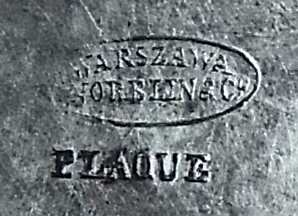
|
Next Norblin mark which
also refers to fusion-based silver deposition. It
has the inscription in Polish "WARSZAWA NORBLIN &
Co" ("WARSAW NORBLIN & Co") inside the oval + one
French word "PLAQUÉ" under the oval. Very rare.
|
|
3
|
c.1853 - c.1855
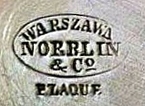
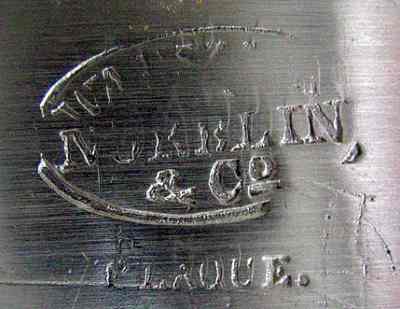
|
This Norblin mark is a variation of the
mark No.2 with the writing of "NORBLIN & Co" in two
lines instead of one. In contrast to the previous
mark in some cases it has a dot (!) after the word "PLAQUÉ".
I think that the presence of a dot could be
connected with the use of galvanic-based silver
deposition, while the absence of the dot could be
connected with the use of fusion-based silver
deposition. Very rare.
|
|
4
|
c.1855 - c.1857
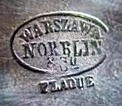
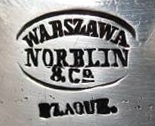
|
Next
mark differs from mark No.3 by a
rounder shape of the oval. Again, the absence/presence
of the dot after the word "PLAQUÉ" could be
connected with fusion-based/galvanic technique of
silver deposition. Very rare.
|
|
5
|
c.1857 - c.1860
|
According to the
description of Wysiadecki collection [6], items
166-169, this
Norblin mark differs from the mark No.4 by the
disposition of French inscription "PLAQUÉ", which is
laid in a cartouche (rectangle) below the oval. In
addition, in some cases the rhombus with "N" letter
is used. The presence of "PLAQUÉ" inscription in a
cartouche means fusion-based silver deposition,
while the additional rhombus with "N" letter refers
to galvanic technique of silver deposition. Such
system of marking is similar to that used by Fraget
in the same period. Very rare/Extremely rare.
|
|
6
|
c.1860 - c.1870
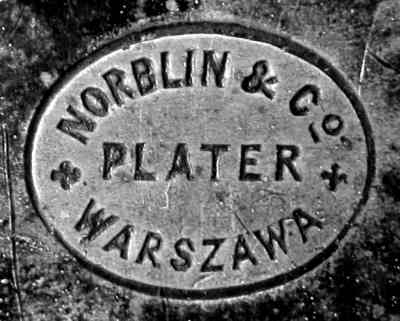
|
Next
Norblin mark refers to only
fusion-based silver deposition. It consists of the
inscription in Polish "NORBLIN & Co PLATER WARSZAWA"
("NORBLIN & Co PLATE WARSAW") inside the oval, the
size of which is about 7.8 mm x 9.4 mm. Note the
famous French sign "Fleur de Lis" (lily flower), put
to the left and to the right of the inscription "PLATER",
which is probably connected with the French origin
of Norblin company. Very rare.
|
|
7
|
c.1860 - c.1870
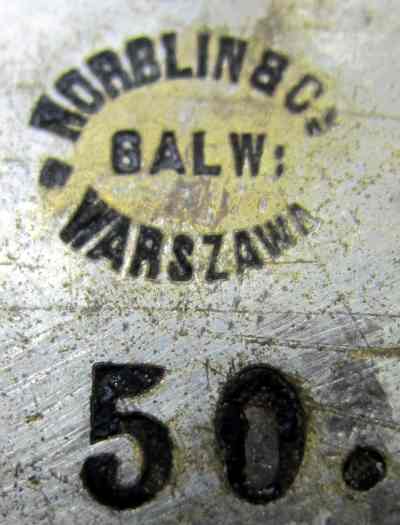
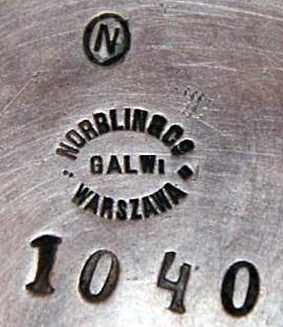
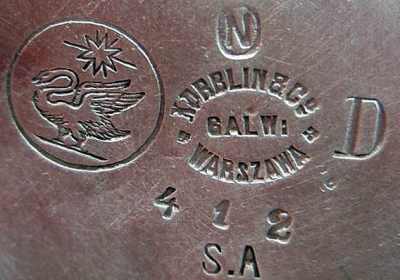
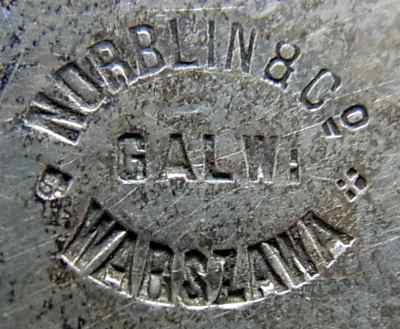
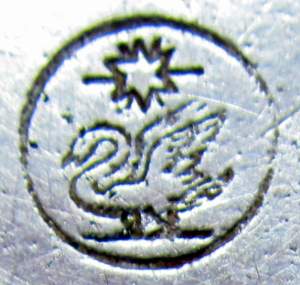
|
This Norblin mark refers to galvanic
silver deposition only. It differs from the previous
mark No.6 by two characteristic details: the absence
of the oval and the presence of the inscription "GALW".
Note the colon (!) after the inscription "GALW" made
of two quadratic points, which again corresponds to
Fraget mark used in the same period. The inscription
"GALW" is the shortening of Polish word "GALWANIZACJA"
("GALVANIZATION") and refers to the method of silver
deposition. The Polish inscription "NORBLIN & Co
GALW: WARSZAWA" ("NORBLIN & Co GALV: WARSAW") forms
the oval. The size of the oval is about 7 mm x 9 mm.
Similar to the mark No.6, the stylized French symbol
sign "Fleur de Lis" (lily flower) is used. In
earlier version of this mark the catalogue number
with a large dot (!) was applied. Later, similar to
Fraget mark of the same period, the small oval with
"N" letter appears, which means “normal thickness
of silver deposited onto the surface of the base
metal (usually on brass)". Note the simultaneous
disappearance of the dot after the catalogue number. Finally,
in the later version of this mark, the circle with
the swan image under the Star of David in some cases
was applied. Very rare/Rare.
|
|
8
|
c.1870 - c.1883
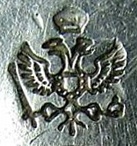
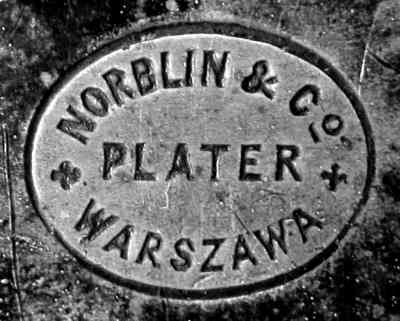
|
Next
Norblin mark is the last one which
refers to fusion-based silver deposition. It is
mentioned in the description of Wysiadecki
collection [6], items 196 and 207. It is similar to
the Norblin mark No.6, over-printed image with the
Coat of Arms of Russian Empire (two-headed eagle,
version with a "separated" crown, used in 1857 -
1883). As I do not possess the photo of this mark, I
am presenting its characteristic details only.
Extremely rare.
|
|
9
|
c.1872 - c.1883
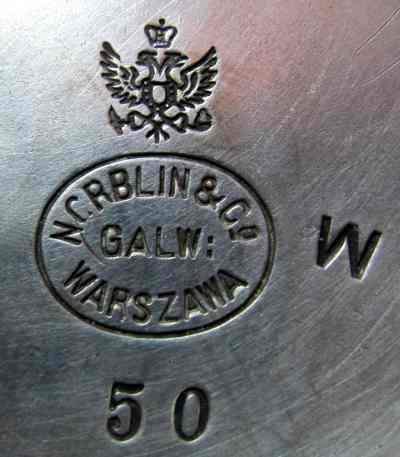
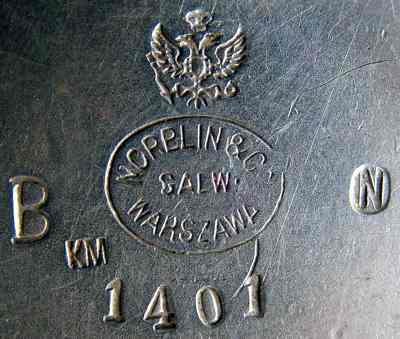
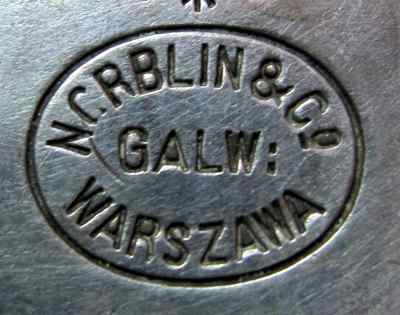
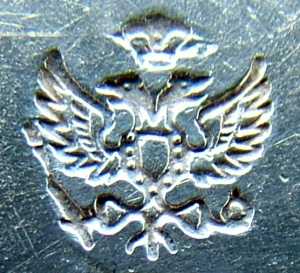
|
This Norblin mark refers to galvanic
silver deposition. It differs from the mark No.7 by
two characteristic details: firstly, the
reappearance of the oval, and, secondly, the
presence of the Coat of Arms of Russian Empire (two-headed
eagle, version with a “separated” crown, used in
1857 - 1883). Note that the colon after the
inscription "GALW" is made of two quadratic points
as before. Attention! Very often one of two points
is missing. The size of the oval varies between 8.1
mm x 10.7 mm and 8.5 mm x 12 mm. The circle with the
swan image under the Star of David is absent.
Sometimes, the letter "N" in a small oval, which
means "normal thickness of silver deposited onto
the surface of the base metal (usually on brass),"
is present. Common.
|
|
10
|
c.1883 - c.1896
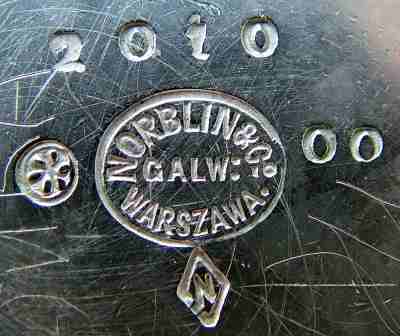
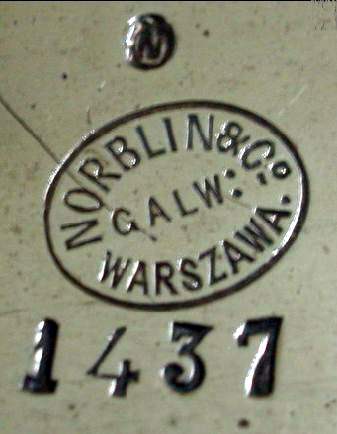
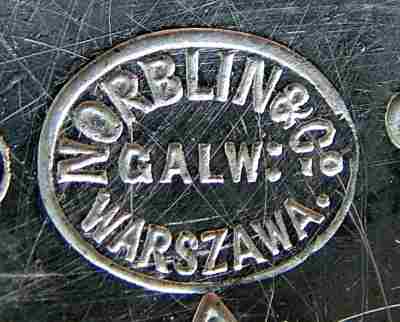
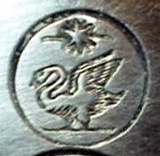
|
Next Norblin mark refers to
galvanic silver deposition. It differs from the
previous mark No.9 by three characteristic features:
firstly, by disappearance of Russian State Coat of
Arms; secondly, by appearance of a dot (!) after the
word "WARSZAWA"; and, thirdly, by the use of two
round dots to form a colon after the inscription "GALW".
The mean size of oval is 8 mm x 10 mm. Sometimes,
the letter "N" inside a rhombus (or inside a small
oval), is used. That means "normal thickness of
silver deposited onto the surface of the base metal
(usually on brass)". In some cases, the circle with
the swan image under the Star of David appears.
Common.
|
|
11
|
c.1896 - c.1901
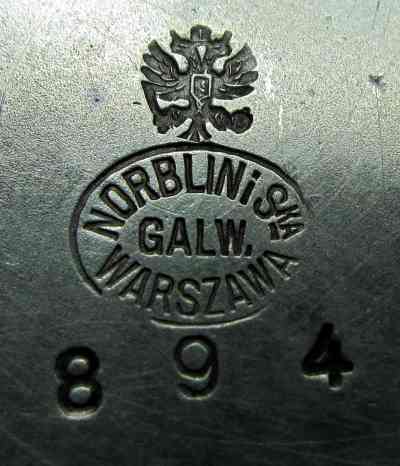
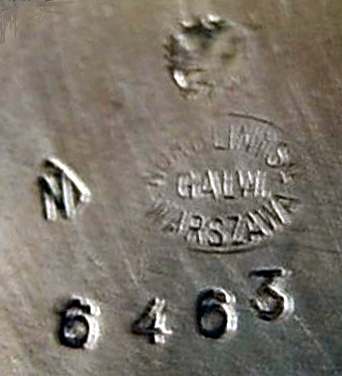

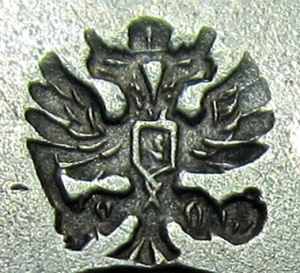
|
This Norblin mark refers to galvanic
silver deposition. It differs from the mark No.10 by
four essential features: firstly, the appearance of
Russian State Coat of Arms, which according to last
editing made in 1883, has a crown "glued" to the
two-headed eagle; secondly, the use of Polish
inscription "NORBLIN i Ska" instead of
English "NORBLIN & Co"; thirdly, the appearance of
a dot after the word "GALW" instead of a colon, and
fourthly, the disappearance of a dot after the word
"WARSZAWA". The mean size of the oval decreases down
to 4.9 mm x 6.7 mm. The letter "N" inside a rhombus
means "normal thickness of silver deposited onto the
surface of the base metal (usually on brass)". Rare.
|
|
12
|
c.1901 - c.1906
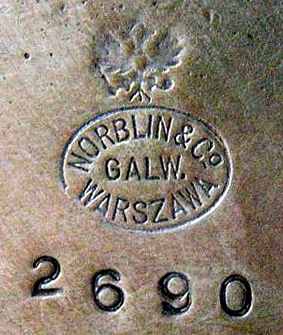
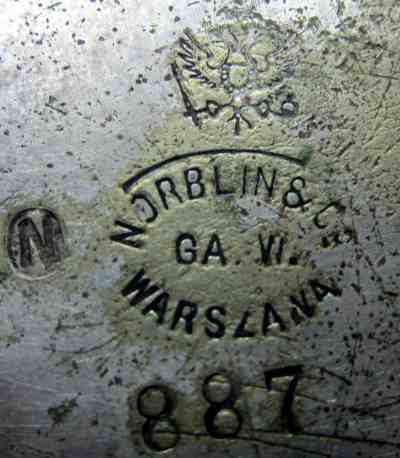
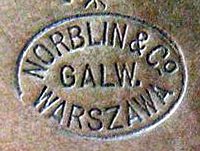
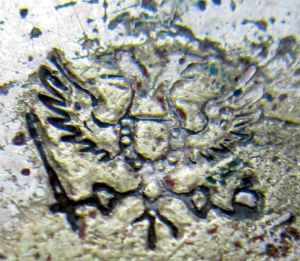
|
Next
Norblin mark also refers to galvanic
technique of silver deposition. It differs from the
previous mark No.11 by a return from Polish
inscription "NORBLIN i Ska" to the English
one "NORBLIN & Co". The mean size of the oval
corresponds to that for the mark No.10, namely, 4.9
mm x 6.8 mm. The letter "N" in a small oval means "normal
thickness of silver deposited onto the surface of
the base metal (usually on brass)". Rare.
|
|
13
|
c.1906 - c.1914
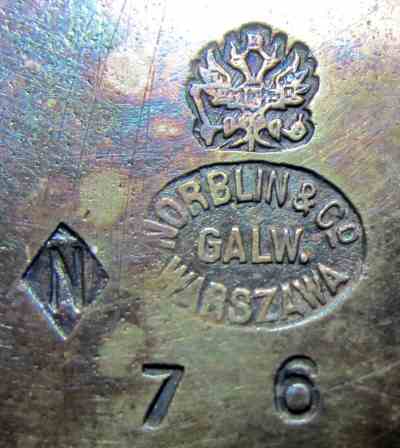
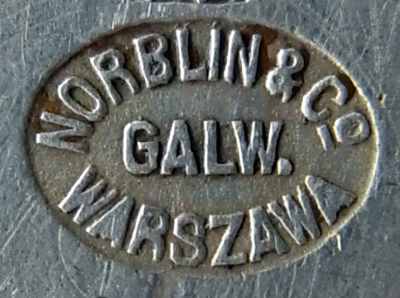
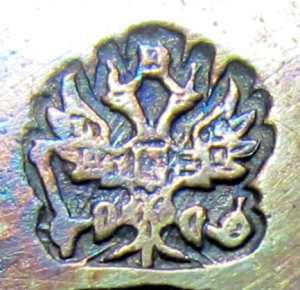
|
This Norblin mark also
refers to the galvanic silver deposition. It differs
from the previous mark No.12 by the printing of two
main mark elements, the oval and the two-headed
eagle, as bas-reliefs on a flat surface. The size of
the oval varies between 4.4 mm x 5.8 mm and 5.3 mm x
7.1 mm. The letter "N" inside a rhombus (or inside a
small oval) means "normal thickness of silver
deposited onto the surface of the base metal (usually
on brass)". Relatively common.
|
|
14
|
c.1908 - c.1914
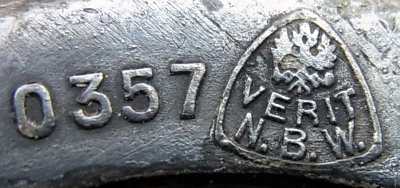
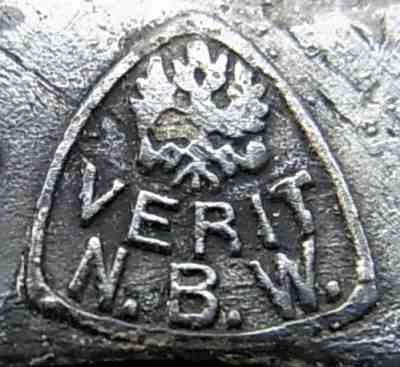
|
This mark of N.B.W. company
was applied when using the newly-invented tin alloy
VERIT as a base metal for silvering. This mark
consists of convex triangle of 6.9 mm height and 7.5
mm width. Inside the triangle under the Russian
State Coat of Arms is the inscription "VERIT N.B.W.".
Rare.
|
|
15
|
after 1914
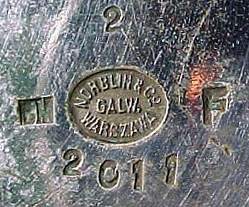
|
A variation of Norblin mark
No.13 without the Russian State Coat of Arms. Rare.
|
Acknowledgements
I would like to acknowledge the help of two people, Mr.
Sergei Kruglov, who shared with me the photographs of
Norblin marks from his collection of tea glass holders, and
Mr. Alexander Maroutian, who allowed me to photograph the
marks on Norblin pieces from his collection. My e-mail
address is niko@phys.ucc.ie. Any comments, questions or
letters with additional information are very welcome.
However, please do not send any requests for valuation
and/or expertise, such letters will be ignored.
LITERATURE
[1] David N. Nikogosyan. Marks of European Silver Plate: II.
Fraget & Norblin, Poland/Russia.
http://www.silvercollection.it/ASCASFRAGET.html, 2009.
[2] David N. Nikogosyan. Marks of European Silver Plate: XII.
Fraget, Russia/Poland
http://www.ascasonline.org/windowAGOS99.html.
[3] Wincenty Norblin. http://pl.wikipedia.org/wiki/Wincenty_Norblin
[in Polish].
[4] Ludwik Norblin. http://pl.wikipedia.org/wiki/Ludwik_Wincenty_Norblin
[in Polish].
[5] Joanna Paprocka-Gajek. Platery Warszawskie w Latach
1822-1914. Warszawa: Muzeum Palac w Wilanowie, 2010, pp.1-375
[in Polish]. English translation: Silver Plated Items produced
by Warsaw factories in 1822-1914.
[6] Maria Ejchmann. Platery. Katalog Zbioru Platerów
Warszawskich im. Anieli i Tadeusza Wysiadeckich. Warszawa:
Muzeum Woli, 2005, pp.1-107 [in Polish]. English translation:
Warsaw Silver Plate. Catalogue of the collection, gathered by
Aniela and Tadeusz Wysiadecki.
[7] Svetlana Kaikova. Silver Replacement Techniques in Russia.
Antiques, Art and Collectables, N°1, pp.65-78 (2002) [in Russian].
[8] Elena Elkova. "Plaqué" and "Doublé" Techniques in French
Silver Plate Production. Antiques, Art and Collectables, N°4
(46), pp.76-84 (2007) [in Russian].
Dr. David N. Nikogosyan
- 2012 -
|
|

